Piecewise linear regression with scikit-learn predictors#
Links: notebook, html, PDF, python, slides, GitHub
The notebook illustrates an implementation of a piecewise linear regression based on scikit-learn. The bucketization can be done with a DecisionTreeRegressor or a KBinsDiscretizer. A linear model is then fitted on each bucket.
from jyquickhelper import add_notebook_menu
add_notebook_menu()
%matplotlib inline
import warnings
warnings.simplefilter("ignore")
Piecewise data#
Let’s build a toy problem based on two linear models.
import numpy
import numpy.random as npr
X = npr.normal(size=(1000,4))
alpha = [4, -2]
t = (X[:, 0] + X[:, 3] * 0.5) > 0
switch = numpy.zeros(X.shape[0])
switch[t] = 1
y = alpha[0] * X[:, 0] * t + alpha[1] * X[:, 0] * (1-t) + X[:, 2]
import matplotlib.pyplot as plt
fig, ax = plt.subplots(1, 1)
ax.plot(X[:, 0], y, ".")
ax.set_title("Piecewise examples");
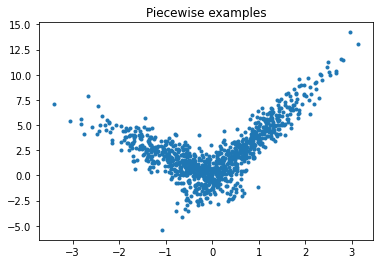
Piecewise Linear Regression with a decision tree#
The first example is done with a decision tree.
from sklearn.model_selection import train_test_split
X_train, X_test, y_train, y_test = train_test_split(X[:, :1], y)
from mlinsights.mlmodel import PiecewiseRegressor
from sklearn.tree import DecisionTreeRegressor
model = PiecewiseRegressor(verbose=True,
binner=DecisionTreeRegressor(min_samples_leaf=300))
model.fit(X_train, y_train)
[Parallel(n_jobs=1)]: Using backend SequentialBackend with 1 concurrent workers.
[Parallel(n_jobs=1)]: Done 2 out of 2 | elapsed: 0.0s finished
PiecewiseRegressor(binner=DecisionTreeRegressor(min_samples_leaf=300),
estimator=LinearRegression(), verbose=True)
pred = model.predict(X_test)
pred[:5]
array([0.38877424, 2.59190533, 0.96242534, 3.40015406, 1.20811239])
fig, ax = plt.subplots(1, 1)
ax.plot(X_test[:, 0], y_test, ".", label='data')
ax.plot(X_test[:, 0], pred, ".", label="predictions")
ax.set_title("Piecewise Linear Regression\n2 buckets")
ax.legend();
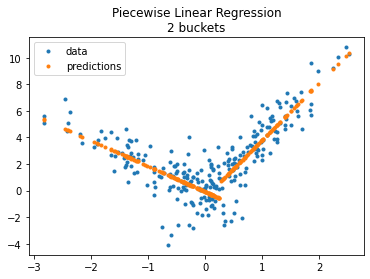
The method transform_bins returns the bucket of each variables, the final leave from the tree.
model.transform_bins(X_test)
array([0., 1., 0., 1., 1., 0., 0., 1., 0., 1., 0., 0., 1., 1., 1., 1., 0.,
0., 1., 1., 0., 1., 0., 0., 0., 0., 1., 1., 1., 0., 0., 1., 1., 0.,
1., 0., 1., 0., 0., 0., 1., 0., 1., 1., 1., 0., 0., 0., 0., 1., 0.,
1., 0., 0., 0., 1., 0., 0., 0., 1., 0., 0., 1., 1., 0., 1., 0., 0.,
0., 1., 1., 1., 1., 0., 0., 1., 0., 0., 0., 0., 1., 0., 1., 0., 0.,
0., 1., 1., 0., 0., 1., 0., 0., 1., 0., 0., 0., 0., 1., 1., 0., 0.,
1., 0., 1., 0., 1., 0., 0., 1., 0., 1., 0., 1., 1., 1., 0., 0., 1.,
0., 1., 0., 0., 0., 0., 1., 0., 1., 0., 0., 1., 1., 0., 1., 0., 0.,
0., 0., 0., 1., 1., 1., 0., 0., 1., 0., 0., 1., 0., 1., 0., 0., 0.,
0., 1., 0., 1., 1., 0., 1., 0., 0., 0., 0., 0., 0., 0., 0., 1., 1.,
1., 0., 0., 0., 1., 0., 1., 1., 1., 1., 0., 0., 0., 1., 0., 1., 1.,
1., 1., 0., 0., 0., 0., 0., 1., 0., 0., 1., 1., 1., 0., 0., 0., 1.,
0., 1., 0., 0., 0., 0., 0., 0., 1., 0., 1., 0., 0., 0., 1., 0., 1.,
1., 1., 0., 1., 0., 1., 1., 1., 0., 0., 0., 1., 0., 0., 0., 0., 0.,
1., 0., 1., 0., 1., 0., 1., 0., 0., 1., 1., 1.])
Let’s try with more buckets.
model = PiecewiseRegressor(verbose=False,
binner=DecisionTreeRegressor(min_samples_leaf=150))
model.fit(X_train, y_train)
PiecewiseRegressor(binner=DecisionTreeRegressor(min_samples_leaf=150),
estimator=LinearRegression())
import matplotlib.pyplot as plt
fig, ax = plt.subplots(1, 1)
ax.plot(X_test[:, 0], y_test, ".", label='data')
ax.plot(X_test[:, 0], model.predict(X_test), ".", label="predictions")
ax.set_title("Piecewise Linear Regression\n4 buckets")
ax.legend();
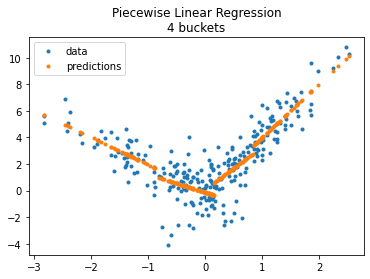
Piecewise Linear Regression with a KBinsDiscretizer#
from sklearn.preprocessing import KBinsDiscretizer
model = PiecewiseRegressor(verbose=True,
binner=KBinsDiscretizer(n_bins=2))
model.fit(X_train, y_train)
[Parallel(n_jobs=1)]: Using backend SequentialBackend with 1 concurrent workers.
[Parallel(n_jobs=1)]: Done 2 out of 2 | elapsed: 0.0s finished
PiecewiseRegressor(binner=KBinsDiscretizer(n_bins=2),
estimator=LinearRegression(), verbose=True)
fig, ax = plt.subplots(1, 1)
ax.plot(X_test[:, 0], y_test, ".", label='data')
ax.plot(X_test[:, 0], model.predict(X_test), ".", label="predictions")
ax.set_title("Piecewise Linear Regression\n2 buckets")
ax.legend();
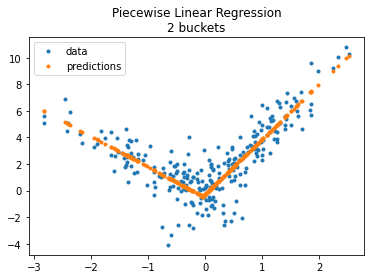
model = PiecewiseRegressor(verbose=True,
binner=KBinsDiscretizer(n_bins=4))
model.fit(X_train, y_train)
[Parallel(n_jobs=1)]: Using backend SequentialBackend with 1 concurrent workers.
[Parallel(n_jobs=1)]: Done 4 out of 4 | elapsed: 0.0s finished
PiecewiseRegressor(binner=KBinsDiscretizer(n_bins=4),
estimator=LinearRegression(), verbose=True)
fig, ax = plt.subplots(1, 1)
ax.plot(X_test[:, 0], y_test, ".", label='data')
ax.plot(X_test[:, 0], model.predict(X_test), ".", label="predictions")
ax.set_title("Piecewise Linear Regression\n4 buckets")
ax.legend();
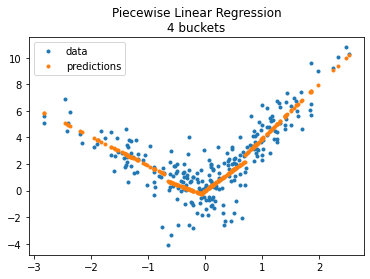
The model does not enforce continuity despite the fast it looks like so. Let’s compare with a constant on each bucket.
from sklearn.dummy import DummyRegressor
model = PiecewiseRegressor(verbose='tqdm',
binner=KBinsDiscretizer(n_bins=4),
estimator=DummyRegressor())
model.fit(X_train, y_train)
0%| | 0/4 [00:00<?, ?it/s][Parallel(n_jobs=1)]: Using backend SequentialBackend with 1 concurrent workers.
100%|██████████| 4/4 [00:00<?, ?it/s]
[Parallel(n_jobs=1)]: Done 4 out of 4 | elapsed: 0.0s finished
PiecewiseRegressor(binner=KBinsDiscretizer(n_bins=4),
estimator=DummyRegressor(), verbose='tqdm')
fig, ax = plt.subplots(1, 1)
ax.plot(X_test[:, 0], y_test, ".", label='data')
ax.plot(X_test[:, 0], model.predict(X_test), ".", label="predictions")
ax.set_title("Piecewise Constants\n4 buckets")
ax.legend();
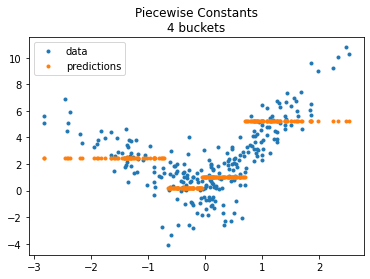
Next#
PR Model trees (M5P and co) and issue Model trees (M5P) propose an implementation a piecewise regression with any kind of regression model. It is based on Building Model Trees. It fits many models to find the best splits.